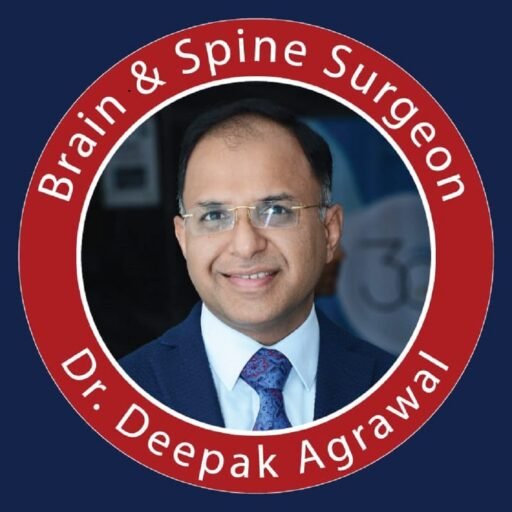Collectively headache disorders are among the most common of the nervous system disorders, with a prevalence of 48.9% in the general population. I Dr. Deepak Agrawal, a renowned Professor of Neurosurgery at the All India Institute of Medical Sciences in New Delhi (AIIMS), cordially invite you to delve into the fascinating realm of headaches.
In this blog, we will go on a trip to uncover the mysteries of this frequent condition and throw light on efficient techniques to relieve the agony. I am going to deliver significant insights in simple language, making complicated medical topics understandable to anyone.
Whether you get sporadic headaches or wish to learn more about the complexities of head pain, this article will provide you with knowledge and practical advice.
Join us on an educational journey into the world of headaches, where clarity meets compassion in the search for relief.
What is a Headache?
Headaches are a common source of discomfort, causing pain in the head or neck, especially behind the eyes and inside the ears. Any soreness in these areas is considered a headache. Headache strength and duration vary.ost headaches are transitory and can be treated with rest or over-the-counter drugs, severe or chronic occurrences may necessitate expert medical treatment.
They stand out as the most common form of discomfort and contribute significantly to missed work or school days, prompting visits to healthcare professionals. While most headaches are harmless, certain forms might indicate a more serious problem. Understanding the fundamentals of headaches enables us to manage and cure this common kind of suffering.
Why Do Headaches Occur?
Headaches occur for various reasons, often rooted in changes within the brain. These changes may result from shifts in chemical values or alterations in blood vessels.
Genetic factors can sometimes play a role The brain’s sensitivity to pain and external factors like stress or lack of sleep can also trigger headaches. Headaches are essentially the body’s method of warning that something isn’t quite right.
Understanding these characteristics can assist with headache management and prevention, paving the road for a healthy, pain-free life.
Common headache types and causes
Tension and migraine headaches are the most prevalent forms of headaches. Tension headaches occur when the muscles of the head and neck contract.
Migraines occur when the brain’s supersensitive nerve endings cause pain. But what causes the muscles to stiffen or particular nerve endings in the brain to become too sensitive? That is less well understood.
These headache reasons might differ from person to person. However, some causes are frequent. Tension headaches are frequently triggered by:
- Stress
- Tiredness
- Lack of sleep
- Hunger
- Caffeine withdrawal
- Symptoms Caffeine-containing drugs, such as ibuprofen (Advil) or acetaminophen (Tylenol), should be discontinued abruptly.
- Weather variations
- Eating junk such as chocolate, processed meals containing monosodium glutamate (MSG), and alcohol are examples of foods and beverages.
Types of Headache
There are around 150 different forms of headaches. They are classified into two types: primary and secondary headaches.
Primary Headaches
Primary headaches are caused by the dysfunction or overactivity of pain-sensitive elements in your brain. They are neither a sign of nor the result of an underlying medical problem. Some persons may be predisposed to primary headaches due to genetic factors. Primary headaches are classified as follows:
- Tension headaches: Tension headaches are the most prevalent form of headache. In this type of headache, pain starts above the eye. Pain starts on both sides of the head as well.
- Migraines: Migraines are severe headaches. There is discomfort on the face and neck with this sort of headache. There is a lot of trouble seeing and hearing with severe headaches. The discomfort is also accompanied by nausea and clouded eyesight.
- Headaches in clusters: In this, there is pain concentrated on one side of the head and around the eye. In this pain the pupils become small and the nose starts running. In such pain, sometimes one side of the eye becomes red.
- Sinus: Due to sinus headache, there is pain in the face, forehead, sinus, eyes, and ears. Some people get a runny nose, itching, swelling on the face, and fever.
Some lifestyle factors or conditions can cause primary headaches, such as:
- Alcohol, especially red wine.
- Certain foods, such as nitrate-containing processed meats (food-related headaches). Nicotine consumption (nicotine headache).
- Sleep changes or a lack of sleep.
- Bad posture.
- Exertion headaches are caused by physical activities such as exercise.
- Meals were skipped (hunger headache).
- Coughing, sneezing, blowing your nose, straining (for example, when having a bowel function), or forcefully laughing or sobbing (primary cough headaches).
Primary headaches are rarely harmful, but they can be excruciatingly painful and disturb your daily life.
Secondary Headaches
Secondary aches and pains Secondary headaches are caused by an underlying medical problem. They are seen as a symptom or indicator of a disease. Secondary headaches that aren’t necessarily hazardous and go away if the main ailment is addressed are as follows:
- A headache caused by dehydration.
- Headaches are caused by the sinuses.
- Headaches are caused by medication misuse.
Secondary headaches can be a signal of a serious or even life-threatening medical condition.
Spinal Headaches: Spinal headaches are severe headaches that develop when spinal fluid comes out of the membrane that covers your spinal cord, generally following a spinal tap.
Thunderclap Headaches: A thunderclap headache is a severe headache that occurs suddenly, similar to a clap of thunder. This form of headache has a one-minute peak in discomfort and lasts at least five minutes. While thunderclap headaches are occasionally innocuous, it is critical to seek prompt medical assistance. They can indicate Brain damage such as bleeding in the brain, the syndrome of reversible cerebral vasoconstriction, or a sudden increase in blood pressure.
How Do We Know That Our Headache Is Serious?
Consult your physician as soon as possible if: Your headaches either wake you up from sleep or make it difficult for you to go to sleep. A headache lasts for several days. Morning headaches are the worst. You’ve had headaches in the past, but their pattern or strength has altered. You suffer frequent headaches with no recognized reason.
Can Headache Be Fatal?
In general, headaches themselves are not fatal, but they can signal serious underlying conditions that may pose risks. Severe headaches, like those associated with conditions such as hemorrhagic strokes or meningitis, can be life-threatening. However, most headaches are benign and manageable. It’s crucial to differentiate between common headaches and those indicative of more severe issues. Seeking medical attention for sudden, severe headaches, especially with neurological symptoms, is essential. While headaches alone are typically not fatal, understanding and addressing their root causes is crucial to ensure overall health and well-being.
Natural Treatments For Headache?
To naturally alleviate headaches, consider these remedies:
- Hydration: Dehydration can trigger headaches, so drink plenty of water.
- Rest: Ensure sufficient sleep and take breaks to relax.
- Cold Compress: Apply a cold compress to the forehead for 15 minutes.
- Warm Compress: A warm compress on the neck and shoulders can ease tension headaches.
- Herbal Teas: Peppermint or ginger tea may have soothing effects.
- Aromatherapy: Inhale lavender or peppermint essential oils.
- Caffeine: A moderate amount can relieve certain headaches.
- Manage Stress: Practice relaxation techniques like deep breathing and yoga.
However, if headaches persist or worsen, consult a healthcare professional to rule out underlying issues.
Conclusion
As we journey through the intricate world of headaches, it becomes evident that understanding their types, causes, and potential seriousness is crucial for effective management. From primary headaches like tension and migraines to secondary headaches indicating underlying medical issues, the diverse nature of head pain requires tailored approaches.
Recognizing warning signs, such as changes in headache patterns or severe symptoms, prompts the importance of seeking medical attention promptly. While most discomfort in the head is not inherently fatal, it can be indicative of serious conditions requiring urgent intervention.
The comprehensive exploration also sheds light on natural remedies, emphasizing hydration, rest, and stress management. In my capacity as a neurosurgery professor, I encourage everyone to prioritize their well-being, promptly address unusual headaches, and embrace holistic approaches for a healthier, pain-free life.
Reference
https://www.ncbi.nlm.nih.gov/pmc/articles/PMC4590146/
https://www.aiims.edu/index.php?lang=en
https://www.ncbi.nlm.nih.gov/books/NBK560787/
https://www.ncbi.nlm.nih.gov/books/NBK513272/
https://drdeepakaiims.com/blog/?playlist=19d647e&video=6a3773d
https://pubmed.ncbi.nlm.nih.gov/29083833/#:~:text=Meningitis%20is%20a%20life%2Dthreatening,rate%20of%20close%20to%2025%25.






